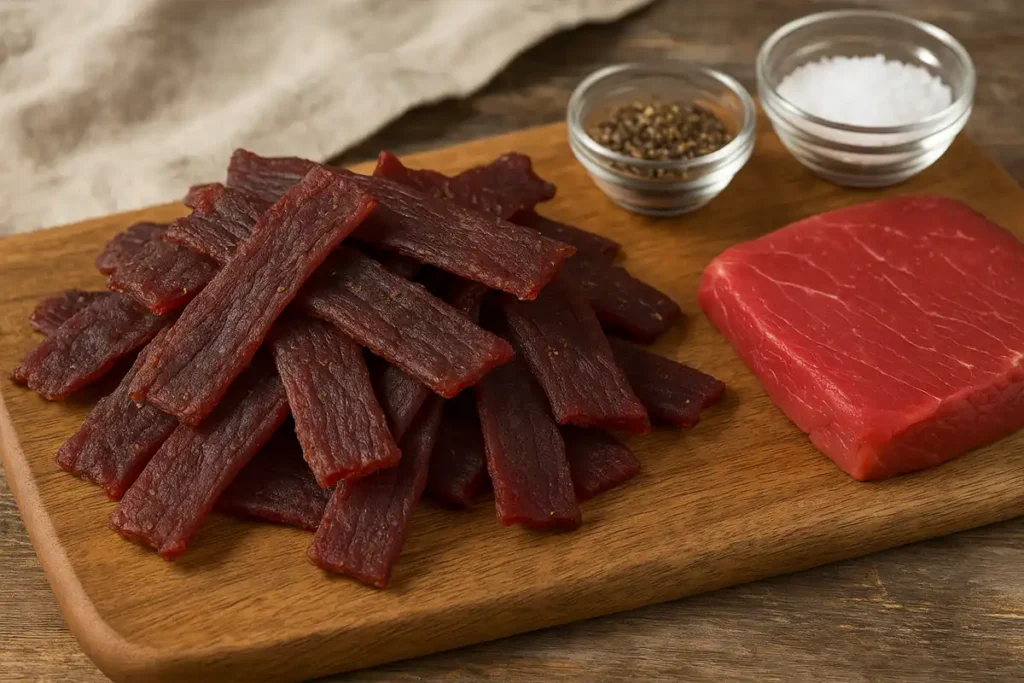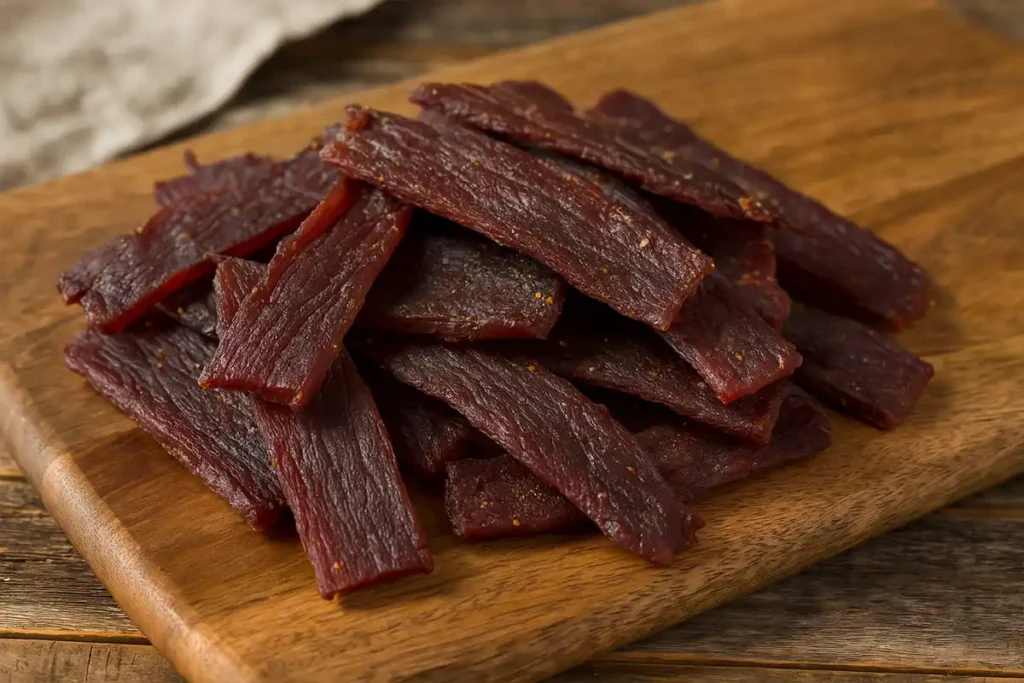Making your own beef jerky at home can be a satisfying experience – it’s flavorful, long-lasting, and gives you control over ingredients. If you’re new to this, choosing the right meat is the first step. The best meat for beef jerky isn’t just about flavor, it’s also about texture, leanness, and ease of preparation. In this guide, we’ll walk you through the ideal cuts, preparation steps, health benefits, and more to get your jerky journey off to a confident start!
What is the Best Meat for Beef Jerky?
When it comes to jerky, the quality and type of meat make a huge difference. The best meat for beef jerky is lean, firm, and low in fat. Fat doesn’t dehydrate well and can cause spoilage. That’s why lean cuts like eye of round, top round, bottom round, and sirloin tip are considered ideal. These cuts offer the right balance of flavor and texture for delicious, chewy jerky without too much grease.
Best Meat for Beef Jerky: Top 4 Cuts
Eye of Round
Often recommended by jerky lovers, this cut comes from the rear leg of the cow. It’s super lean and easy to slice. Plus, it has very little connective tissue, making it great for tender jerky.
Top Round
Another popular choice. This one is slightly more flavorful than eye of round and still pretty lean. It’s a bit more affordable too, which is a win-win.
Bottom Round
A little tougher than the other rounds, but still works well. This cut can give your jerky a bit more chew, which some people love.
Sirloin Tip
This cut is lean and tender with a bit more richness in taste. It’s slightly more expensive but worth it if you want jerky with a bit more depth.

Ingredients for Homemade Beef Jerky
- 2–3 pounds of lean beef (eye of round or top round recommended)
- 1/2 cup soy sauce (low sodium if preferred)
- 1/2 cup Worcestershire sauce
- 1 tablespoon onion powder
- 1 tablespoon garlic powder
- 1 teaspoon ground black pepper
- 1 teaspoon smoked paprika
- Optional: 1 tablespoon brown sugar for a touch of sweetness
Preparation Instructions
- Trim all visible fat from the beef to avoid spoilage
- Freeze the meat for 1 hour for easier slicing
- Slice the beef against the grain, about 1/8 to 1/4 inch thick
- Mix all marinade ingredients in a large bowl
- Add beef strips and let them marinate in the fridge for 6–24 hours
- Preheat your oven to 175°F (or use a dehydrator if you have one)
- Arrange beef slices on a rack or tray in a single layer
- Dry for 3–6 hours, flipping halfway through, until firm but flexible
- Let cool completely before storing in an airtight container
Therapeutic Benefits of Making the best meat for beef jerky
The process of slicing, marinating, and slowly drying beef can be surprisingly meditative. Prepping jerky allows you to focus, slow down, and enjoy the rhythm of kitchen work. There’s something deeply satisfying about turning raw ingredients into a tasty, preserved snack – a rewarding project that calms the mind.
Health Benefits of Beef Jerky
When made at home, beef jerky can be a high-protein, low-carb snack with no added preservatives. Lean cuts used for jerky are rich in iron, zinc, and B vitamins – essential for energy and immune function. Plus, by skipping commercial additives, you make a cleaner, healthier version of your favorite road-trip snack.
FAQ for the article best meat for beef jerky
What is the best cut of meat for beef jerky?
Eye of round is widely considered the best meat for beef jerky due to its lean profile, low cost, and easy slicing.
How much jerky will 5lbs of meat make?
You’ll typically get about 2 pounds of jerky from 5 pounds of raw meat, depending on the moisture loss during drying.
What meat is typical in jerky?
Beef is the most common, especially lean cuts like round and sirloin. Some people also use turkey, venison, or bison.
Is it cheaper to make jerky or buy it?
Making jerky at home is usually cheaper in the long run, especially when buying meat in bulk. Plus, it allows full control over flavor and quality.
Budget-Friendly Tips for Making Jerky at Home
If you’re just starting out, don’t feel pressured to buy expensive cuts. Look for deals at your local butcher or ask for trimmings that can still be used if they’re lean. Buying in bulk or during sales and slicing at home saves money. A manual meat slicer or sharp knife helps keep slices consistent without needing fancy gear.
You can also skip a dehydrator if you’re on a budget. A regular oven on low heat works just fine. Just leave the oven door cracked open a bit for airflow. Homemade jerky can cost half the price per ounce of store-bought versions.
Storage Tips and Shelf Life of Beef Jerky
Once cooled, beef jerky should be kept in airtight containers or vacuum-sealed bags. For short-term, store it in a cool, dark place – it can last up to 2 weeks. For longer shelf life (up to 1–2 months), refrigerate it. For 3–6 months of preservation, freeze your jerky.
If you see condensation in the bag or strange smells, toss it. Always cool completely before storing to avoid moisture buildup – moisture is the enemy of jerky.
Flavoring Variations with a Therapeutic Twist
One of the best parts of homemade beef jerky is the creative freedom. You can play with spices that suit your mood or health goals. Want a calming flavor? Try a touch of turmeric and ginger. Need something warming? A pinch of cinnamon and cayenne can uplift your senses.
Cooking with intention can turn the process into a relaxing, even therapeutic ritual. Choose herbs that connect with your emotions or remind you of comforting memories.
A Bite of History – Jerky Through the Ages
Did you know jerky dates back to the Incas? The word “jerky” comes from the Quechua word “ch’arki,” which means dried, salted meat. Indigenous cultures from North and South America used the sun, smoke, and wind to dry meat and preserve it for long journeys or winters.
Today, jerky is a protein-packed snack made worldwide. But the satisfaction of drying your own meat, just like ancient civilizations, connects us to something timeless and primal.
Final Thoughts
The best meat for beef jerky is lean, accessible, and easy to slice – but the real magic happens when you turn it into something you made with care. Whether you’re in it for the savings, the health, or just the fun, making jerky is a satisfying journey. Every batch teaches something new, and every bite reminds you that slow food can be the most rewarding.
So what do you think about our article best meat for beef jerky ? leave a comment.

